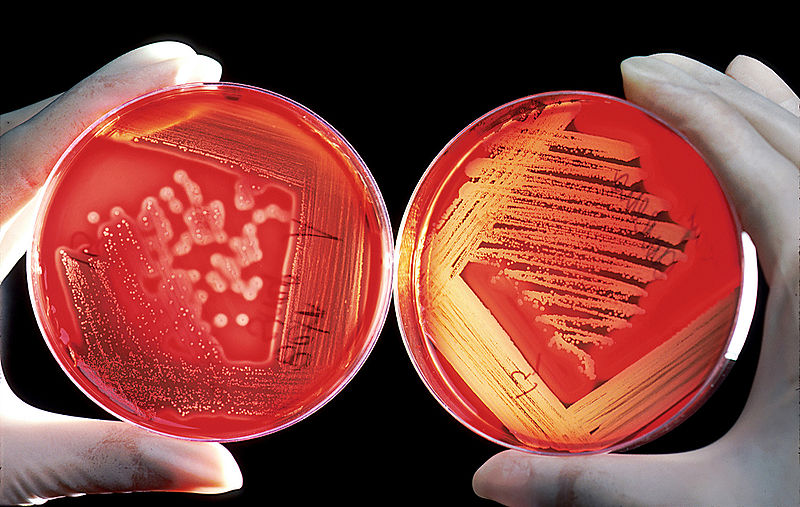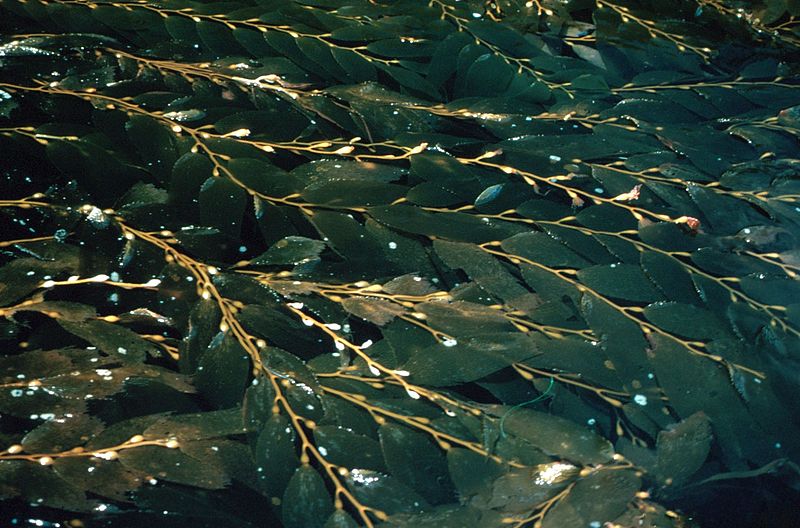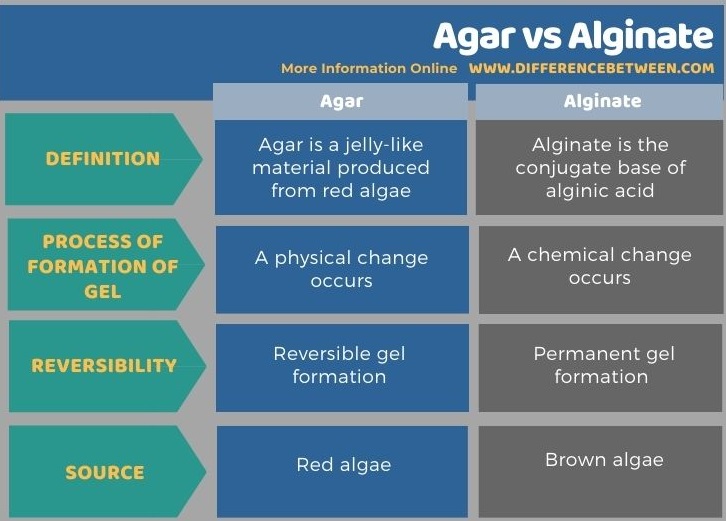Difference Between Agar and Alginate
The key difference between agar and alginate is that agar is obtained from red algae, whereas alginate is obtained from brown algae.
Agar and alginate are substances that we can use interchangeably in their applications because they have similar appearances and functions. However, their origins are different from each other.
CONTENTS
1. Overview and Key Difference
2. What is Agar
3. What is Alginate
4. Similarities Between Agar and Alginate
5. Side by Side Comparison – Agar vs Alginate in Tabular Form
6. Summary
What is Agar?
Agar is a jelly-like material produced from red algae. There are two major components of agar: linear polysaccharide agarose and heterogeneous mixture of small molecules known as agaropectin. This material can form the supporting structure of the cell walls of certain algae species. However, agar releases from the cell wall upon boiling. The algae type that contains agar is known as agarophytes. They belong to the Rhodophyta (red algae) phylum.

Figure 01: Agar Plated for Blood Analysis
Agar is useful as an ingredient in desserts in the Asian region, but it is commonly used as a solid substrate containing culture media for microbiological work. It is also useful as a laxative, as an appetite suppressant, as a vegetarian substitute for gelatin, as a thickener for soups, as an ingredient in fruit preserves, ice cream, and other forms of desserts, and as a clarifying agent in brewing. It is also occasionally useful for sizing paper and fabrics.
The component that causes the jelly-like nature in agar is the unbranched polysaccharide, which is obtained from the cell walls of some species of red algae. However, for commercial applications, agar is obtained primarily from ogonori.
Among the two components of agar, agarose and agaropectin, agarose makes up about 70% of the mixture. Agarose is a polymer material (a linear polymer) containing the repeating units of agarobiose. Agarobiose is a disaccharide made of D-galactose and 3,6-anhydro-L-galactopyranose. On the other hand, agaropectin contains alternating units of D-galactose and L-galactose that are modified with acidic side groups.
What is Alginate?
Alginate is the conjugate base of alginic acid. Alginic acid is a polysaccharide that occurs in the cell walls of brown algae. This substance is hydrophilic, and it can form a viscous gum upon hydrating. It can form salts such as sodium alginate and calcium alginate with metal ions. The appearance of this material can range from white to yellowish-brown.

Figure 02: Brown Algae
The alginate we know at present is a developed structure that is useful as a substitute for agar when agar became uncommon during World War II. Typically, this material is commonly used than agar, mainly in dental impression at present due to the ease of use.
Alginate is commercially available as bulk packing and as pre-weighed packets for individual use. Usually, we are given a plastic cylinder along with this commercially available alginate form for the measuring of water. We can typically mix 16 grams of this powder with 38 mL of water to get the desired end product. The ingredients of commercially available alginate include soluble alginates such as sodium alginate, zinc oxide, calcium alginate, potassium titanium fluoride, diatomaceous Earth (the filler substance), sodium phosphate, colouring agents and flavouring agents.
Generally, alginate has a pleasant taste and odour. Sometimes it also has some flavours, including strawberry, orange, mint and vanilla flavour. However, alginate has a poor tear strength and the most common factors that affect this strength include the amount of water used, mixing time, time of removal of impression, etc.
What are the Similarities Between Agar and Alginate?
- Agar and alginate appear as jellies when hydrated.
- They are in “sol” state in their application.
- Both materials are obtained from seaweed.
- We can use alginate as a substitute for agar because they share many similarities.
What is the Difference Between Agar and Alginate?
Agar is a jelly-like material produced from red algae while alginate is the conjugate base of alginic acid. The key difference between agar and alginate is that agar is obtained from red algae, whereas alginate is obtained from brown algae. Moreover, in the formation of gel, agar undergoes a physical change while alginate undergoes a chemical change.
Below is a summary of the difference between agar and alginate in tabular form.

Summary – Agar vs Alginate
Agar and alginate share many similarities and difference as well. The key difference between agar and alginate is that agar is obtained from red algae, whereas alginate is obtained from brown algae.
Reference:
1. Singla, Ishu. “Alginate. Dental Material.” SlideShare, Available here.
Image Courtesy:
1. “Agarplate red blood cells edit” By Bill Branson – (Edited by Fir0002)(Edited by Drhx) – This image was released by the National Cancer Institute, an agency part of the National Institutes of Health, with the ID 2230 (Public Domain) via Commons Wikimedia
2. “Giantkelp2 300” (Public Domain) via Commons Wikimedia
ncG1vNJzZmivp6x7pbXFn5yrnZ6YsqOx07CcnqZemLyue8OinZ%2Bdopq7pLGMm5ytr5Wau26txpqpZpmemXqiuMaipZqslWQ%3D